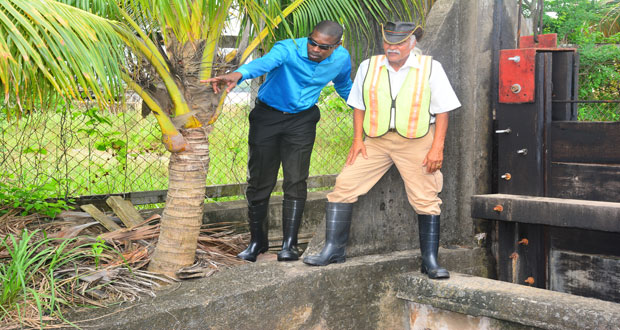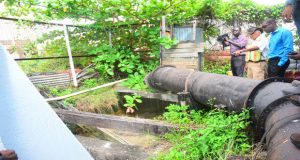Minister Patterson to propose taskforce to examine city drainage

THE Government of Guyana will be looking to immediately establish a multiparty task force including Civil Society to examine in the first instance the drainage of Georgetown and secondly the restoration of the city.This proposal will be formally made to Cabinet in the coming days by Public Infrastructure Minister, Honourable David Patterson who made the announcement during a press conference on Sunday evening while addressing the issue of flash flooding in several parts of the country. The press conference was held in television studios National Communications Network Inc.
During the press conference the minister noted that one of the issue that contributed to the flooding of the city and coastland had to do with “too many bosses” amounting to some six different agencies which have responsibility for drainage in Guyana and who in most cases are very territorial much to the detriment of the country.
Minister Patterson told reporters that he today he will be speaking with the Finance Minister, Winston Jordon to see if any emergency funding can be accessed to effect emergency works.
Once that funding is available then the Ministry with the other agencies would be clearing clogged canals, desilting outfalls, and carrying out works on the pumps which are nonfunctional. Those pumps the media was told all fall under the supervision of City Hall. The Government has committed to offering its full support to the council to ensure that it carries out its mandate to reduce the instances of flooding in the city.
On Sunday several parts of the country experienced flooding laid solely at the feet of inoperable pumps, clogged canals and sluices which needed desilting, these causes were confirmed by the minister and made even more evident on Monday when the minister took the media on a tour of the facilities around Georgetown and its environs.
Minister Patterson related on Sunday that Georgetown and the coastland experienced 5 inches of water within four to five hours of rainfall. He also pointed out that Georgetown which was the worst affected area only has the capacity to drain a small amount of water, to be precise 1 ½ inches of water every twenty four hours.
On Sunday, Minister Paterson, Agriculture Minister Noel Holder and Mayor Hamilton Green and teams from their respective agencies visited several of the areas which were under water accessing the discomfort that residents were experiencing. Sunday’s visit also found that out of a total of thirteen sluices in Georgetown only two were functional while two of out six pumps were operable.
By yesterday most of the water had drained off the land but there was still a considerable amount of water in main drains and canals which peak their banks while some roads within the city still had sections of it in sheets of water. The draining of the land took place more rapidly in areas outside of Georgetown as was evident by midmorning yesterday Monday.
Yesterday, Monday, Minister Patterson was accompanied by Civil Engineer within the Ministry of Public Infrastructure, Walter Willis where they were able to get a better look at sluices, pumps and outfalls as they were not at the level of water present on the land as on the previous day.
One of the appalling discoveries yesterday was a sluice on Water Street that drains Lamaha Street that has been inoperable for years to the extent that it was estimated to have approximately fourteen feet of slit to be cleared coupled with other works to make it functioning.
Had that sluice been operating many of the flood waters which have been affecting the Kingston area over the past years would have been able to drain off the land even faster than it drained whenever the community was affected by floods.

The Minister and Walter Willis at the sluice in Kingston which has been inoperable for several years now
Among the areas visited yesterday included Kingston, Water Street, Meadow Bank, Ruimveldt and Agricola.
On Sunday the media was also informed that as of 17.00 hrs that day, the water in the East Demerara Water Conservancy was at 58 GD while the maximum is normally 60 GD it was pointed out that should the water continue to rise then the water would have to be released through the Lama Sluice and in a worst case scenario the Mahaica area would have to be used to drain the water.
There will be no releasing of water in the Hope Canal since the water has no way of getting into the Atlantic Ocean at this time and although the NDIA last week said that once the conservancy gets at that critical stage the Hope Canal will be tested, the Public Infrastructure Minister reported that the position has been revisited.
By Leroy Smith



